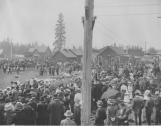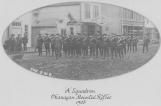1
01) Beginnings 1908 - 1914- Formations and locations
- Uniforms
- Unit structure
- Militia in BC
- Social events
- Visitors
3
The present day Reserve Army unit of the Canadian Forces, the British Columbia Dragoons (BCD), started as a cavalry squadron on April 1, 1908 in Vernon, British Columbia (BC). It was called the Okanagan Mounted Rifles, a popular but unofficial name which stuck for many years. There had been previous attempts to create a cavalry unit in Vernon, the largest community in the Okanagan Valley at the time. The first three, in 1884, 1887 and 1896 failed to find official backing in Ottawa. The fourth attempt in 1898, had official backing but failed locally.Another squadron (Sqn) was formed in Kamloops. In 1909 squadrons were authorized in the Nicola Valley and the Coldstream Ranch areas, and together the four cavalry squadrons were officially named the BC Horse (BCH).
By 1911 new squadrons had been formed in Salmon Arm, Wallachin, Lumby, Armstrong and Kelowna. The Okanagan squadrons in Armstrong, Vernon, Lumby, Coldstream and Kelowna became the 30th Regiment, BC Horse (30thBCH), with Headquarters in Vernon. Thereafter, the other squadrons became the 31Regiment, BCH, Headquartered in Kamloops.
5
First inspection parade of the Okanagan Mounted Rifles. General Otter was the inspecting officer.June, 1909
Vernon, BC, Canada

6
Camp Kelowna held in the summer of 191x. The view is across the lake to the W, NW.1912
Exhibition Grounds, near Knox Mountain, Kelowna, BC, Canada

7
Much development of the Regiment in the pre-World War I period depended upon self-help. Troopers supplied their own horse and much of the equipment, though they did receive uniforms and rifles on occasion, from Ottawa. By 1913 there was relative uniformity in clothing and equipment.The typical Trooper (Tpr) on parade wore a Stetson hat, scarlet tunic with yellow facings or trim, light khaki breeches, dark khaki puttees, tan leather boots, spurs, and a leather bandolier of ammunition over his shoulder. He would carry a Ross rifle and in his pack a pair of dark blue cavalry trousers with a yellow stripe, for dress occasions. He was paid $1.00 per day for himself and $1.00 per day for his horse.
10
The distance between squadrons dictated that training for much of the year was strictly a local affair. Each sqn of about 50 to 70 men, ideally consisted of a Major (Maj), a Captain (Capt), four Lieutenants (Lt), a Medical Officer (MO), a Veterinary Officer (VO), a Farrier Sergeant (Sgt), six Corporals (Cpl), a Trumpter, two Shoeing Smiths, a Saddler, forty mounted Troopers (Tpr) or Privates (Pte), ten dismounted Privates and a Transport Driver. It would conduct parades and drill on the open ranges near town, with lectures on military topics to supplement the physical training.Every year in June the Regiment would concentrate in either Vernon or Kamloops, which proved too dusty. Vernon was chosen as the permanent site for summer Militia camps in the interior regions of BC in 1912. By 1914 nearly 2,000 militiamen were attending the annual camp including members of the 30th and 31st BCH, the Seaforth Highlanders of Canada (SHC), the Rocky Mountain Rangers (RMRgs), the Corps of Guides, and the Duke of Connaught's Own Rifles (DCOR), from Vancouver.
12
Comments in the annual inspection report by Colonel (Col) R. L. Wadmore for 1911 said, "I consider all squadrons of the BCH much superior to the average Eastern cavalry as these men can ride, and therefore have only to put their horses into their places and learn their own duties. These mounted units in BC are therefore a distinctly valuable asset to the Defence of Canada."In 1912 a contingent from the regiment provide part of the mounted escort honour guard for His Highness, the Duke of Connaught, Governor-General of Canada during his visit to Victoria and Vancouver, BC. They made a good impression upon him as "the stalwart, bronzed-faced men from the upper country" mounted on "splendid horses."






